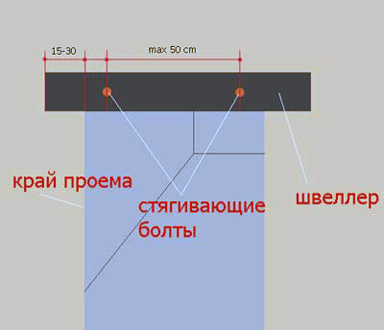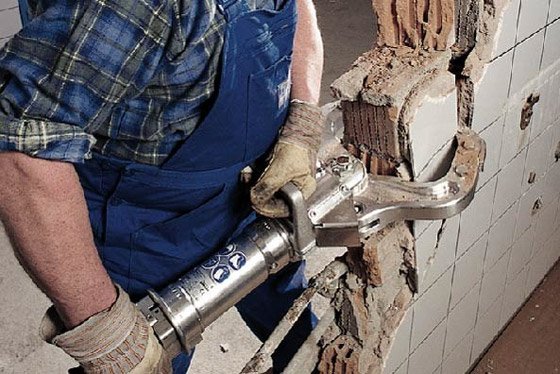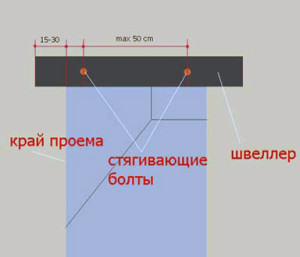Gymnastics for the neck of Dr. Shishonin, the video of which we propose to watch, ...


Many residents of apartments multi-storey buildings not satisfied with the standard layout of their home.
The main problem in the implementation of redevelopment is the ban on the demolition of load-bearing walls.
And this is logical, because then the structure of the building will weaken, and it may collapse. But is the situation so hopeless? Is it possible to break down walls and punch holes in a load-bearing wall?
This question is asked by those who have decided to optimize the living space for their own requirements. This question is unequivocal - no, the demolition of the load-bearing wall is prohibited, because it reduces the structural strength of the entire house. During the construction of any building, special engineering calculations are made that establish the number and dimensions of load-bearing walls to ensure its safe operation.
However, demolition of the wall is not the only way to change the layout. For example, you can make an opening in a load-bearing wall. It can replace a complete demolition.

Openings in load-bearing walls are permitted only if the following requirements are met:
When creating an area redistribution plan, it is necessary to make sure that no communications pass through the dismantled wall.
Strengthening openings in load-bearing walls is one of the main requirements for demolition work.
Therefore, before starting work, it is necessary to make a jumper that will take on the load of the house instead of the dismantled section.
The dimensions and material of the jumper are indicated in the technical report. It can be a channel or powerful corners. The jumper should rest directly on the place where the destruction of the wall occurs.
The manufacture of load-bearing jumpers is carried out in several stages:

As a result, the reinforcing structure should look something like this:

Before continuing work, it is necessary to wait for the mortar to dry in the reinforcing channel structure. This may take about 4 days. During this time, you can prepare the necessary tool:
Before starting dismantling work, it is necessary to install wooden supports, which will serve as protection against the destruction of the ceiling. As insurance, do not neglect this requirement.
The dismantling process itself consists in the gradual chipping of concrete from the wall until an opening of the desired size is formed.
The most time-consuming is the device of an opening in the bearing wall in a panel house, because the supporting structures are made of high-strength monolithic concrete, it is not easy to break its integrity.
In order to make openings in the load-bearing walls of your apartment, you do not need to neglect the requirements for obtaining a permit, because the safety of all residents of the house is at stake. It is strictly forbidden to dismantle sections of the bearing wall without the permission of the relevant organizations.
To break is not to build, everyone knows this saying. Indeed, at first glance, no difficulties are expected. You wanted redevelopment, your own apartment, and the neighbors will tolerate a little noise. But when it comes to load-bearing walls, everything is much more complicated.
Multi-storey buildings, especially those built during the Soviet period, have a margin of safety. But if you remove the supporting walls completely, then the structure may collapse - it’s not in vain that they insist on engineering calculations and approval of redevelopment. Therefore, it is better to abandon the idea of completely getting rid of the load-bearing wall immediately. And its partial dismantling or making an opening is a real question.

Before demolishing the load-bearing wall, it is required to install a jumper, which will partially take on the load. The easiest way is to use a steel jumper, which structurally consists of two channels (sometimes I-beams or powerful corners are used), bolted at a distance of 40-50 cm. The finished jumper should rest on the edges of the future opening up to 15-30 cm long.
But before the manufacture / installation of the jumper, it is necessary to insure against the collapse of the ceilings and install the logs vertically, which will take the load on themselves if the concrete protective layer of the slabs is destroyed during the work and they move.

First, a few tips. First, do not rush to get rid of the props until the solution is completely dry. Secondly, make sure that there are no wires in the contour of the future opening. electrical network and other communications. Thirdly, choose the right tool for dismantling.
The load-bearing wall, especially in a panel house, is a monolith of extremely durable concrete. If you are making an opening in masonry, then it is quite possible to use a jackhammer, puncher, or even a sledgehammer. For a concrete wall, this tool is not suitable:
For efficient dismantling of carriers concrete walls modern diamond cutters are used. They allow you to make an opening quickly and very accurately, which, in turn, will facilitate the subsequent finishing work.
Many people, especially those who live in Khrushchevs, are trying to remake their small and uncomfortable apartments with the help of redevelopment. If it is still possible to perform it in an individual building, then how to change the doorway or move the partition in a high-rise building, where almost every wall is a carrier? All this should ensure the safety of residents in combination with the entire technical design of the house. If you decide to do it, then you definitely need to find out which walls in the apartment are load-bearing. It is quite simple to determine this on your own, you just need to know exactly how to do it.
To begin with, it should be noted that the carrier is called the wall that takes on the load of the elements located above it, including beams, floor slabs and walls. Load-bearing walls are not always used in the interior, instead of them there may be columns and beams that rely on them. Such a system is called a rack-and-beam system.
You can take the easy route and find a floor plan for your home. It should clearly indicate which wall is load-bearing and which is not. The plan is usually in the Management capital construction. With the help of a constructive plan, you can still find the columns and beams of the post-beam system, as well as the floor slabs that rest on them.
If for some reason you were unable to obtain a constructive plan of the building, then you can determine the load-bearing walls by characteristic features, for example, by their thickness or material. V panel houses internal blocks have a thickness of up to 120 mm, so they are considered partitions (their thickness varies between 80-120 mm). But the thickness of the bearing surface should not be less than 140 mm. As a rule, in such houses, the outer walls are made from 200 mm thick. V brick houses external, load-bearing structures, as a rule, have a thickness of more than 380 mm, inter-apartment - 250 mm, and partitions - 120 or 80 mm.
In panel-type houses, wall or inter-apartment blocks are mainly used as a material for, which are made of reinforced concrete with various additives to facilitate construction and increase thermal protection. In almost all panel houses, internal partitions are made of gypsum concrete panels. In brick buildings, red and silicate bricks are usually used for all walls, differing in size. The main material for the partitions they also have are gypsum concrete panels.
It is not possible to completely demolish the load-bearing walls, because the ceiling slabs rest on them. Their complete elimination can lead to a weakening of the ceiling, as well as a decrease, which is unacceptable. Only partial dismantling is allowed, in which part of the load-bearing wall is left, transferring the load to the foundation from the upper elements. It is also very important to correctly redistribute the load between the rest of the wall and auxiliary elements. Most often, their role is played by metal or wooden supports, which are located in the opening in a vertical position at a distance of no more than 1 m from each other. A beam is also installed on them, which takes the main load. Demolition of the wall should start from the top. After dismantling and complete completion of work to strengthen the opening, the supports can be removed.
Many are interested in the question: is it possible to ditch load-bearing walls? Unfortunately, this question cannot be answered unambiguously. Shtroblenie significantly weakens the bearing capacity of the walls, so this event is prohibited at the legislative level, if we are talking about multi-apartment panel houses, and there are quite a lot of these nowadays. It must be remembered that gating can damage the protective layer of the wall, which, in turn, should protect the internal reinforcement from corrosion.
Even if your house is not a panel house, you will still have to coordinate this issue with the authorities by prescribing electrical wiring and wall chasing in your redevelopment project. Most likely, you will be denied the right to ditch the load-bearing wall, but if the house is brick, the chances of success increase significantly. Do not forget that load-bearing walls, even if officially allowed, require a particularly careful and careful approach.